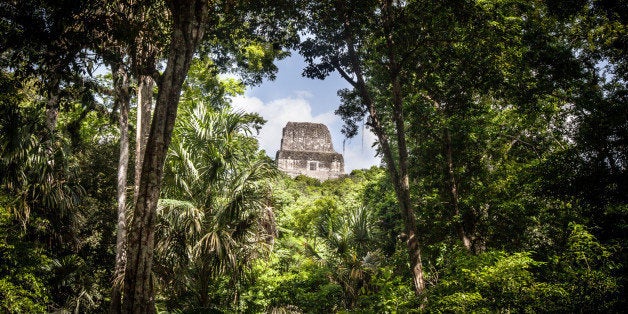
The Paris talks related to climate change have ended and now we all face the challenge of limiting global warming and meeting the aspirational goal to cap temperature rises to 1.5C. This objective can only be achieved by not only focusing on reducing use of fossil fuels, but also by tackling emissions resulting from land use, particularly deforestation and sustainable land management. In addition to being addressed at COP21 in Paris, these twin issues are among the 17 Sustainable Development Goals adopted by the United Nations General Assembly in September 2015. Because forest conversion, when combined with direct greenhouse gas emissions from agricultural production, is responsible for 24 percent of the world's total carbon pollution, it makes good sense to look at joint solutions to these problems.
One extremely successful model of how to address climate change and sustainable land management is occurring right now in Guatemala, which is one-third forested and already severely impacted by climate change.
Recently, Guatemala has made headlines with its government transition--most noticeably manifesting itself in the election of former comedian Jimmy Morales as president--and its success in working with United Nations to root out corruption. This collaboration, which has been hailed by The Guardian as a model for the transformation of other fragile states, is a cause worth celebrating. Despite these advances, Guatemala faces significant climate-related challenges.
According to the Global Climate Risk Index, Guatemala is one of the world's top ten countries most affected by climate change, despite having one of the lowest carbon footprints in the world. In terms of per capita emissions of carbon dioxide, 2011 numbers from the United Nations show it as the Western Hemisphere's second lowest emitter, coming in behind Haiti. In addition to earthquakes, Guatemala's geographical position, extending over three tectonic plates and two oceans, makes it susceptible to tropical storms, droughts and hurricanes. These disasters have been occurring with increasing frequency over the past decade. Recently, heavy rains resulted in a mudslide outside the capital city, leaving more than 280 dead. Weeks of stormy weather and infrastructure weakened by recurring flooding were the immediate causes, but deforestation is a contributing factor to these frequent occurrences. Fortunately, and despite the loss of 10.6 percent of its forest cover between 1990 and 2013, Guatemala is making steady headway in developing initiatives to protect its forest resources.
But how is it doing this? The answer: By being an innovator in promoting sustainable community-based forest management.
According to the United Nations, forests provide food security and shelter and are key to combating climate change, protecting biodiversity and the homes of indigenous populations. Around the world, more than 1 billion people carve their livelihoods out of forest landscapes. Communities that harvest timber and forest goods are no longer doing so to meet only their own needs, but also to supply a global market in forest products that has grown to $327 billion. Yet, if managed correctly, this growing demand for forest products can benefit poor rural populations. This is especially important for Guatemala, whose rural population is among the poorest and whose forest system is one of the most extensive and diverse in Central America.
Guatemala's forests are home to much of the country's more than 3,000 species of vertebrates, including jaguars, ocelots, monkeys and macaws, and 8,600 species of plants. And of equal importance, they are increasingly being recognized as sources of sustainable livelihoods and natural carbon sinks. The crown jewel of these forests is the Classic Maya heartland of the Petén, home to the Maya Biosphere Reserve and a UNESCO World Heritage Site. The 2.1 million hectares of the Maya Biosphere Reserve also serve as one of the first examples of multiple-use forest management with the twin aims of conservation and social development.
Divided between areas that are strictly protected and that are open to forestry and agricultural activities, the reserve serves as a model of how sustainable, community-based forest management can provide biodiversity conservation, economic returns and carbon emission reductions. Recent studies have demonstrated that deforestation rates are significantly lower in areas managed by local communities according to strict sustainability standards than in the core zone "protected" area. What's more, local enterprises have generated thousands of jobs and now achieve more than $9 million in annual sales. Through a coalition of international and local non-government organizations and multilateral and government support, communities in the Petén--and throughout Guatemala--are providing a model of how to profit from sustainable forestry and drive local economic opportunity among marginalized populations.
During a recent trip to the Petén, I visited a group of local women who have organized into a collective to gather and process ramón fruits, often referred to as "nuts." The nutrient-rich seeds are an important part of the traditional Mayan diet. The women-owned collective is responsible for collecting and transporting the ramón nuts to a central location, where they are then hand-dried and processed into a powder that can be made into cookies, biscuits and other baked goods. This processing center offers many women their first experience of gainful employment. Similar opportunities are provided through the harvesting and processing of other non-timber forest products, such as xate or palm fronds, which are used in Palm Sunday observances.
Local communities are also looking to benefit financially from reduced carbon emissions. The GuateCarbon project--which is managed as a partnership between the Guatemalan government and local communities, with the support of international organizations--will allow concessionaires to benefit from the sale of carbon credits generated by the avoided greenhouse gas emissions resulting from the enhanced protection and oversight of more than 660,000 hectares of forest. According to the most recent estimates, the project will reduce carbon dioxide emissions by 7.5 million tons over the next 10 years.
Pilot projects such as ramón nut processing and GuateCarbon are offering revenue streams that not only provide job opportunities to women, but also ensure the continued integrity of the country's natural ecosystems. As such, they serve not only as models for the remainder of Guatemala, but for the globe.
As demonstrated by the recent COP21 meetings in Paris, one of the keys to moving forward on climate change is to balance the needs of industrialized nations against those of low-income countries. Through the models in the Petén, Guatemala is demonstrating how protection of forests can contribute to the global market economy, improve local livelihoods--especially for women--and sequester carbon. The world needs more innovative solutions like the work in Guatemala to mitigate climate change in greater numbers. Guatemala can serve not only as a model for anti-corruption measures, but also for community development. Let's hope that with the changes in its political parties, Guatemala keeps its commitment to a low-carbon, densely forested future and continues to develop and promote innovative examples of how the world can meet the Sustainable Development Goals. Our collective future depends on this continued national-level support as well as global recognition of the importance of forests to our planet's health.
